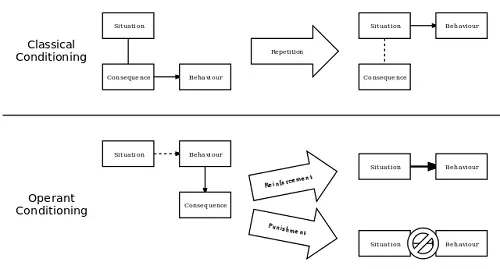What does ‘Operant Conditioning’ mean?
Operant conditioning is a form of learning in which responses that are voluntary hence they come to be controlled by their consequences is also referred as Skinnerian conditioning after a psychologist scholar B.F. Skinner, who worked out its fundamental principles. This conditioning can also be referred as instrumental conditioning due to the learned responses. Usually operate on environment are very instrumental in attaining some of subsequent desirable rewards or avoiding-escaping some subsequent punishing event.
The term instrumental conditioning was coined by Thorndike as a result of his research with cats which were placed in puzzle boxes whereby they learned to escape to obtain food. This research preceded skinner work on operant conditioning in which he showed that by identifying responses and rewards then it is much more possible to produce model chains of behaviours. He carried out research on rats where they were rewarded for pressing bars that had food pellets. While the rat was familiarizing itself with the surrounding, it accidentally pressed the lever and a food pellet was rewarded. The rat kept on pressing the lever and more food pellets were delivered.
Here are few Characteristics of operant conditioning
- To be a reinforce stimuli, it must immediately follow the response and must be perceived as contingent upon the response.
- In operant conditioning source of behaviour is emitted by organism.
- Biological predispositions behaviours are similar to natural or instinctive behaviours are more readily conditioned.
- In operant conditioning performance of behaviour is more influenced by the expectation of reinforcement or punishment.
- Operant conditioning is non-reflexive and of voluntary behaviours
- Operant conditioning exhibits active behaviours that operate on the environment
 between
between
What does ‘Classical conditioning’ mean?
Classical conditioning is an association of one event with another that results in a pattern of behaviour. This conditioning is where responses are usually reflexive and thus elicited. They are brought under the control of stimulus events that precedes the response. It involves learning behaviour through the process of association. Pavlov showed how classical conditioning could be used to make a dog salivate to the sound of bell. Classical conditioning is more associated with a Russian psychologist Ivan Pavlov who worked out its fundamental principles through his studies of salivation in dogs. He identified that it could easily be elicited by stimulus, such as ringing of bell before presenting food to the dog hence it is also referred as Pavlovian conditioning. It is also referred as respondent conditioning.
This conditioning puts more emphasis on the importance of learning from the environment and supports to nurture over nature. It perceives that behaviour is due to an interaction between nature and nurture. It involves two stimuli that are linked together to produce a new learned response in a person or animal. Everything from speech to emotional responses is simply patterns of stimulus and responses.
Here are few crucial characteristics of classical conditioning
- The type of behaviour in classical conditioning is reflexive and involuntary behaviours.
- The source of behaviour in classical conditioning is elicited by stimulus.
- They exhibit both psychological and emotional responses.
- Innate predispositions influence how easily an association is formed between a particular stimulus and response.
- It usually associates two stimuli i.e. conditioned stimulus and unconditioned stimulus.
- It expects that conditioned stimulus reliably predicts the unconditional stimulus.
- Conditioned response decreases when conditioned stimulus is repeatedly presented alone.
Similarities between Operant Conditioning and Classical Conditioning
- In general both classical and operant conditionings are methods of associative learning.
- From historic point of view both operant and classical conditioning are defined as behavioural theories.
- Both scientists describe the phase of associating a former neutral stimulus with an unconditioned stimulus (classical conditioning) and accordingly the association of a response with a consequence and its strengthening (operant conditioning) as the process of acquisition.
- Both operant and classical conditioning exhibit phenomena’s such as generalisation and discrimination
- Both operant and classical conditioning tend to show the tendency of extinction and the mechanism of spontaneous recovery.
Gist of Operant Conditioning and Classical Conditioning
- Classical conditioning puts much effort in emphasizing the importance of learning from the environment and supports nurture over nature
- Classical theory is more of deterministic hence meaning that it does not allow for any degree of free will in the individual e.g. is when a person has no control over the reasons they have learned from classical conditioning such as phobia.
- Many of our behaviours today are shaped by the pairing of stimuli e.g. smells of cologne, songs etc.
Author: Victoria Jones
Victoria Jones has a degree in psychology from UK. She is an expert with over 4 years experience in writing and content strategy. She has written over 50 articles, some of which have been featured in local daily’s and magazines.











Leave a Reply